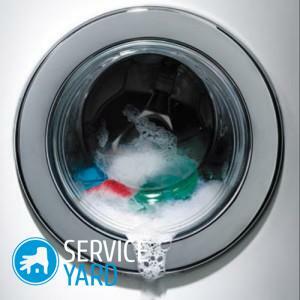Contents:
- Acrylic baths
- How often to wash?
- Removal of
- deposits What tools to use?
- The national tool for the cleanliness of the bath
With the need to clean the plumbing fixtures all the landladies are faced. Before washing an acrylic bath, it is worthwhile to understand what the material from which it is made is. Acrylic is a hard plastic used at first for dental prosthetics, and then it has become very popular for the manufacture of plumbing fixtures. Care for the acrylic bathtub is very simple, besides, they are very light and comfortable, so they quickly replace the old and unaffordable cast iron.
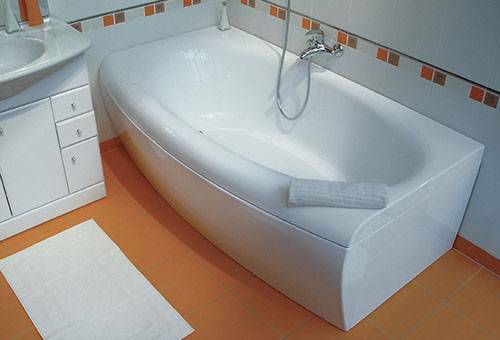
Acrylic baths
Containers made of this material are extruded and cast. In the first case, for structural rigidity, glass fibers and epoxy resin are added, and such a bath is necessarily installed on a metal or moisture-resistant wooden frame.
Molded baths can be put directly on the legs, because they are much more rigid and durable. This strength gives resistance to mechanical damage, so it is much easier to clean such a container, because you do not have to constantly worry about damaging it.
Care for acrylic bathtub simplifies the fact that in the material in the manufacture include additives that prevent the reproduction of fungus, bacteria and mold on the surface. Acrylic is also not subject to any kind of corrosion.
Than wash an acrylic bath? Most impurities can be easily washed off the surface of the bath with plain water and a sponge without the use of cleaning agents. Because the material is easily scratched, the tools used for cleaning should not be abrasive, ie, contain small insoluble particles. The bath is also not recommended to pour cool boiling water.
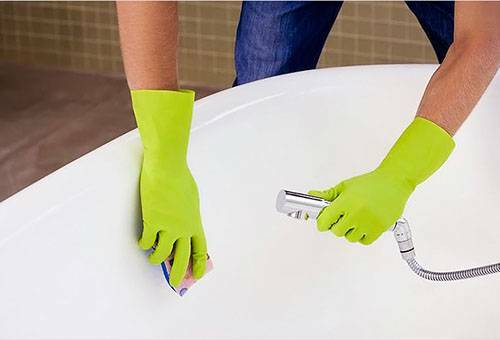
How often to wash?
Than to clean an acrylic bath more often, the better. After all, it is much easier to wash off small contaminants on a regular basis than to try to clean and wipe off deeply stained spots. After each use, the bath should be rinsed with water with mild detergent, eg with liquid soap, and then wiped dry with a rag or an old towel.
To do a bath cleaning at home, more active substances are advised every 2-3 weeks. The agent should be applied to the entire surface, allow it to stand for a while, and then rinse thoroughly.
To ensure that the bath does not show yellowness from constantly dripping water, it is necessary to monitor the serviceability of the cranes and repair them on time. If the surface has already turned yellow, rust should be cleaned with special means designed to remove it.
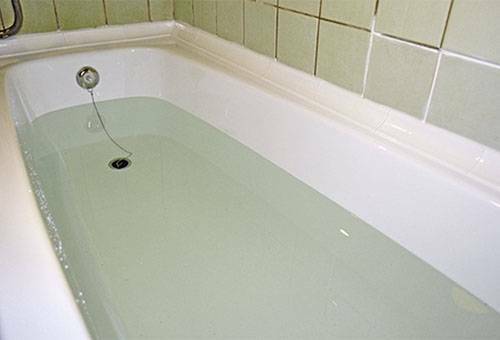
Debris removal
If the tap water is sufficiently rigid, deposits on the acrylic bath regularly occur - the so-called water stone. To remove it you can use the appropriate cleaning agents or more simple folk methods - for example, periodically make a weak acid solution.
- Fill the bathtub with water at room temperature.
- Add 1-2 liters of a weak solution of vinegar or citric acid and mix it thoroughly.
- Leave for 12 hours.
- Release the water, rinse the tub thoroughly and wipe dry with a soft cloth.
Advice
If it is necessary to disinfect the bath at home, the procedure is no different, only add antiseptic agents.

What tools to use?
Care for acrylic bathtub is better to use with soft tools like used for washing dishes. Also suitable is liquid and ordinary soap. To clean the bath, you can rinse out the old bottle of shampoo or shower gel that has ended, because usually there is still a lot of money on the walls. Such soft formulations can be left on the surface of the bath for a long time without the slightest risk of damage.
Than to clean an acrylic bath if it has grown dull and yellowed? To restore her shine, after washing it is smeared with polishing compounds.
Powders like "Pemolux", "Biolan" and Comet, which are cleaned by mechanical friction, are not recommended. Then the question arises: how can I clean the acrylic bath safely? The effect of liquid and pasty substances is more based on chemical removal of contaminants, so they can be used without risking damage to the surface. However, they usually contain substances that are corrosive to the skin, causing irritation and allergy, so it is better to clean the bath in rubber gloves.
So, than to wash an acrylic bath, if the preference is given to industrial means? There is a group of well-proven products.
- Bass is a liquid detergent used to clean baths and showers at home.
- Cif is a universal product for all surfaces in the bathroom.
- "Acrylan" - as the name implies, it is a special tool for acrylic bathtubs and other similar surfaces. It is produced in the form of foam and perfectly copes with mechanical, chemical and biological contaminants and yellowness.
Which means should definitely not be cleaned:
- with abrasive substances;
- with hard metal brushes;
- means with a high content of ammonia, chlorine, acetone or formaldehyde.
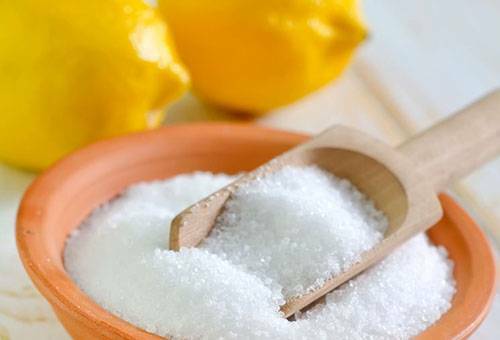
Folk remedy for bath cleanliness
Mistresses often wonder what to clean an acrylic bath - chemicals or natural remedies? For the complex cleaning of yellowness, rust, limescale and yellowish traces of water at home, citric acid is very suitable. It should be diluted in warm water in a ratio of two glasses of water per bag and mix thoroughly. On the surface of the bath the mixture is applied with a usual dish sponge and left for a while. Then, when the acid dissolves the dirt a little, they should be cleaned with the hard side of the sponge in a circular motion, and then rinse the bath thoroughly.
Citric acid is also used to clean the faucets, pipes, tile surface. In the absence of acid, single small dirt can be removed with a slice of lemon - the effect will be no worse.
We also advise you to read: how to clean a bath at home

